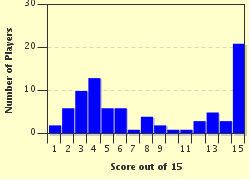Quiz Answer Key and Fun Facts
1. When was Thomas Nashe born?
2. What was Nashe's father's profession?
3. Sometime around 1581, Thomas left home to further his education. Which of the following schools can claim him as an alumnus?
4. Nashe took his degree as Bachelor of Arts in March, 1586, and would have been expected to continue his studies and obtain an advanced degree, but he left the University in 1588, just before he was due to become a Master of Arts. What is the most probable cause of his leaving?
5. Nashe arrived in London sometime in 1588, determined to make his living as a writer. What was his first known published work?
6. Nashe had plenty of competition in the literary marketplace, because London teemed with bright young men who sought to make a living with their pens. Men like Marlowe, Lyly, Robert Greene, Thomas Kyd, and many others. Collectively, these men are known as what?
7. In 1589, Nashe found work defending the Church of England against Puritan attacks. His most famous work during this period, "An Almond for a Parrot," was published under what pseudonym?
8. Little is known of Nashe's activities from 1590 to 1592. Although he must have done a considerable amount of writing, his work was probably published anonymously. He may have received some patronage from a nobleman named Lord Strange, because in 1592 he published a poem dedicated to his Lordship. What was the poem called?
9. On September 3, 1592, Nashe's friend, Robert Greene, died, and after his death was slandered in a pamphlet called "Four Letters." Nashe sprang to his friend's defense, and began one of the most famous literary quarrels in history. Who was the Oxford scholar who became Nashe's most famous enemy and the object of his barbed wit?
10. In 1594, Nashe published what many scholars regard as the first novel written in the English language. What was this important work?
11. Nashe published nothing bearing his name in 1595, and it was not until October, 1596 that his next pamphlet appeared. He probably did a great deal of hack work during this period, but he also received patronage from a powerful government official. Who was Nashe's benefactor?
12. A character in what Shakespearean play is said by some to have been modeled upon Thomas Nashe?
13. In 1597, Nashe found himself in serious trouble with the authorities over this play he co-authored with Ben Jonson.
14. After fleeing London to avoid arrest, Nashe spent some time in Great Yarmouth, Norfolk. He published nothing in 1598, but was probably back in London in 1599, when his last work, "Nashe's Lenten Stuffe," was published. On June 1 of that year, something happened that effectively ended his career as a writer. What was it?
15. When did Thomas Nashe die?
Source: Author
daver852
This quiz was reviewed by FunTrivia editor
Exit10 before going online.
Any errors found in FunTrivia content are routinely corrected through our feedback system.

